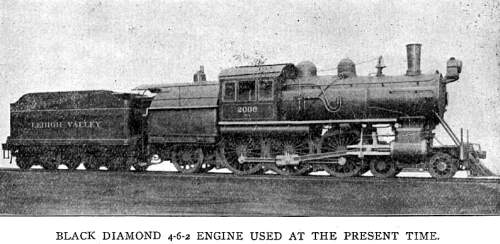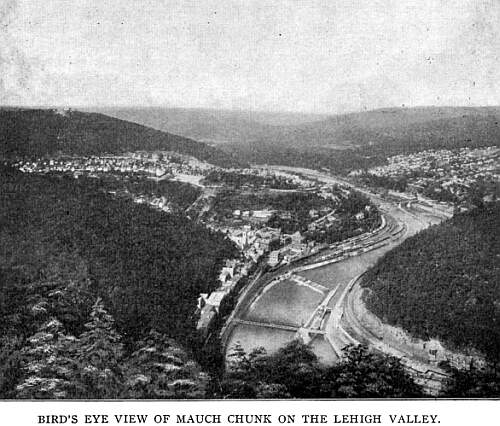|
 The "Black Diamond" on the Lehigh. The "Black Diamond" on the Lehigh.
Whenever you see the representation of a small red
flag, something like a U. S. Commodore's pennant, with a black
centre made in the shape of a lozenge bearing the letters "L.
V.," the whole surrounded with a wreath, that is the emblem
of the Lehigh Valley Railroad. On the flag the black diamond is
a conspicuous figure, and on the road itself the "Black Diamond
Express" is the most important train. The railway was in
former days often thought of only as a coal road, and from this
probably came the idea of the black diamond, but although the
well known emblem has been retained, the road has long ago become
one of the best passenger highways in the land.
Number 9 and Number 10 are the black diamond expresses, the
odd number is the westbound train between New York and Buffalo,
and No. 10 is the eastbound train. The time table distance between
Jersey City and Buffalo is 447.6 miles and No. 9 goes over this
distance in 613 minutes, or at an average speed of 44 miles an
hour. The train consists of one baggage and library car, two day
coaches, a dining car and one Pullman parlor car with an observation
end. The equipment, put on last month, is entirely new, and we
are informed that "This new equipment has been constructed
from plans especially designed to provide the acme of comfort
and safety, and the builders have put upon it the very best skill,
resulting in the production of a train which warrants a renewal
of the name first applied when the Black Diamond Express was inaugurated
in 1896, 'The Handsomest Train in the World.' The train operates
on its present fast schedule between New York and Buffalo, having
a through coach from and to Philadelphia."

The train itself is about 315 ft. long over all and with engine
and tender attached will occupy about 388 ft. of Lehigh Valley
track; but at the average speed made, this whole train would take
just about 6 seconds to pass a person standing by the side of
the track. The estimated weight of the train, without engine and
tender, is 599,770 lbs., so that if a 230-lb. man stepped on board
the train would turn the scale at 300 tons, supposing there was
a scale large enough for it to turn. The baggage and library car
weighs 116,600 lbs.; the two day coaches each weigh 117,660 lbs.;
the diner weighs 131,850 lbs. and the parlor car 116,000 lbs.
The train, therefore, without engine and tender, weighs about
600,000 lbs., and at its average speed of 44 miles an hour it
moves over 3,872 ft. in each minute.
The Lehigh Valley trains pass through a most beautiful part
of the country, and the scenery along the road, especially where
it passes through the mountains, has been called the Switzerland
of America. The high lands in Virginia and Pennsylvania are called
by the general name of the Allegheny mountains. At Easton the
Lehigh river joins the Delaware river and this junction of water
was called by the Indian word lechauwekink, which means
"where there are forks." and this curious word has been
corrupted into Lehigh. The valley of this river is followed as
far as White Haven, where the line strikes across to the Susquehanna
valley at Wilkesbarre. At Lehigh Gap the road winds round the
end of the Blue range, and at Pen Haven it passes through the
Pohopoko mountains.
 Our frontispiece
illustration shows the Black Diamond Express bowling along, beside
the Susquehanna river, near Towanda, Pa. Some of the names of
the towns along the line are interesting in their origin. Towanda,
for instance, is an Indian word, pure and simple. Sayre, close
to the State line between New York and Pennsylvania, was named
after R. S. Sayre, at one time chief engineer of the road. Wilkesbarre
was named in honor of two members of the British parliament who
were noted American sympathizers. They were John Wilkes and Colonel
Barre. Mauch Chunk is from two Indian words, machk meaning
bear, and tschunk, mountain. Scranton comes from the name
of the late Mr. J.H. Scranton. Tunkhannock is from two words used
by the Delaware Indians and means small stream. Our frontispiece
illustration shows the Black Diamond Express bowling along, beside
the Susquehanna river, near Towanda, Pa. Some of the names of
the towns along the line are interesting in their origin. Towanda,
for instance, is an Indian word, pure and simple. Sayre, close
to the State line between New York and Pennsylvania, was named
after R. S. Sayre, at one time chief engineer of the road. Wilkesbarre
was named in honor of two members of the British parliament who
were noted American sympathizers. They were John Wilkes and Colonel
Barre. Mauch Chunk is from two Indian words, machk meaning
bear, and tschunk, mountain. Scranton comes from the name
of the late Mr. J.H. Scranton. Tunkhannock is from two words used
by the Delaware Indians and means small stream.
Our illustrations of the train itself, the coach and the view
of Mauch Chunk, were made from photographs kindly given by Mr.
B. F. Hardesty, chief of the advertising department. The coaches
are lighted by electricity, with Pintsch gas as a reserve, and
are heated by direct steam from the engine, the Gold system being
used.
 The Black Diamond
engines are fine examples of the modern passenger power, and are
hard coal burners. The fact that they consume black diamonds of
the anthracite variety, which does not give off much smoke, has
prompted the management to describe their line as "America's
cleanest railroad." Three engines are required for the run
from Jersey City to Buffalo. The first section is from this terminus
to Easton, a distance of 77 miles; the next run is from Easton
to Sayre, a distance of 194 miles; and the last is between Sayre
and Buffalo, 176.6 miles. The time allotted to each engine is:
for the first, 96 minutes; the second, 287 minutes; and the third,
230 minutes. The middle division is the longest and the hardest,
as in it the road crosses the mountains; but from the traveler's
standpoint it is the most enjoyable, as it is the most picturesque
of any. The Black Diamond
engines are fine examples of the modern passenger power, and are
hard coal burners. The fact that they consume black diamonds of
the anthracite variety, which does not give off much smoke, has
prompted the management to describe their line as "America's
cleanest railroad." Three engines are required for the run
from Jersey City to Buffalo. The first section is from this terminus
to Easton, a distance of 77 miles; the next run is from Easton
to Sayre, a distance of 194 miles; and the last is between Sayre
and Buffalo, 176.6 miles. The time allotted to each engine is:
for the first, 96 minutes; the second, 287 minutes; and the third,
230 minutes. The middle division is the longest and the hardest,
as in it the road crosses the mountains; but from the traveler's
standpoint it is the most enjoyable, as it is the most picturesque
of any.
 At the time
that the photograph was taken, from which our frontispiece halftone
is made, the Black Diamond express was headed by an Atlantic type
engine, and only four cars were hauled. At the present
time these trains are made up of five cars and are hauled by engines
of the Pacific, or 4-6-2 type, and one of these handsome machines
is represented among our illustrations. For this engine and the
information concerning it we are indebted to Mr. F. H. Hibbits,
the superintendent of motive power of the road. The engines have
cylinders 22 x 28 ins.; driving wheels, 76½ ins. diameter;
the tractive effort is about 28,340 lbs. The engine in working
order weighs 241,360 lbs. and with the tender weighs 384,510 lbs.
The train, with the engine and tender to be exact, weighs in all
984,280 lbs., or about 492¼ tons. The total heating surface
of the boiler is 3,858 sq. ft. At the time
that the photograph was taken, from which our frontispiece halftone
is made, the Black Diamond express was headed by an Atlantic type
engine, and only four cars were hauled. At the present
time these trains are made up of five cars and are hauled by engines
of the Pacific, or 4-6-2 type, and one of these handsome machines
is represented among our illustrations. For this engine and the
information concerning it we are indebted to Mr. F. H. Hibbits,
the superintendent of motive power of the road. The engines have
cylinders 22 x 28 ins.; driving wheels, 76½ ins. diameter;
the tractive effort is about 28,340 lbs. The engine in working
order weighs 241,360 lbs. and with the tender weighs 384,510 lbs.
The train, with the engine and tender to be exact, weighs in all
984,280 lbs., or about 492¼ tons. The total heating surface
of the boiler is 3,858 sq. ft.
Suppose the train was on the average 9 ft. 11 ins. wide all
along, counting engine and tender. As a matter of fact, it is
not quite so wide, but for sake of example suppose it was. The
shadow of it on the ground with the sun straight overhead would
in area about equal the total heating surface which is tucked
away in the tubes and fire box of this engine.
Lehigh Valley | Stories Page
| Contents Page
|







